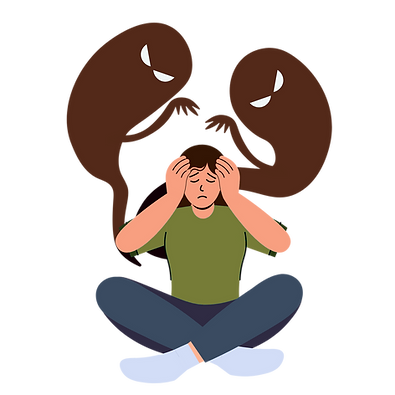EMDR Therapy: A Scientifically-Backed Treatment for Anxiety & Trauma
When talk therapy alone is not enough to heal, EMDR, or Eye-Movement Desensitization and Reprocessing, is a structured therapy to get unstuck. EMDR is backed by 30+ years of research and shows an 80-90% success rate in clinical trials, often surpassing the effectiveness of SSRIs.
EMDR can't erase the past, but it can help process emotional pain in a way that reduces its grip on your present life. Many people experience a reduction in symptoms of anxiety, depression, grief, and intrusive thoughts within 8-12 sessions, along with a deeper sense of peace and self-acceptance. Read on to learn about how EMDR therapy works.

Understanding EMDR Therapy
How is EMDR different from talk therapy?
EMDR is different than talk therapy because it works with the source of emotional distress: your body. While talk therapy helps with cognitive and intellectual processing of what happened, highly distressing emotional experiences directly impact the nervous system. In very simple terms, all emotions have a physical form. When our nervous system is disrupted by a stressful event, emotions can become "stuck" if we do not experience the conditions to fully release them. "Stuck" emotional distress manifests as panic, rumination, tearfulness, irritability, hyper vigilance, dissociation or zoning out, and other emotional reactions that feel out of place. It is not uncommon to have these symptoms even when you feel you have moved on from the past.
EMDR brings the mind and body into sync and taps into the body's natural healing processes (see below).
How does the nervous system heal?
Emotional stress has a natural response cycle to help you heal. It is similar to how the body heals from a wound.
To survive more primitive times, our bodies evolved to respond to threats by fighting back, fleeing the threat, or freezing up and playing dead. To complete the cycle after the fight/flight/freeze response, the body must learn that the threat has passed and you are now safe. This allows the nervous system to come back to baseline. Completing the emotional stress response cycle is more straightforward with primitive threats, like escaping a bear that is chasing you. But with many modern stressors, our bodies never get a clear signal that the threat has passed. Our brain continues to scan our environment and look for threats. This can create ongoing symptoms that we commonly identify as anxiety, depression, or PTSD. Emotional pain can even cause physical illness (also known as psychosomatic disorders).

What will EMDR be like?
EMDR therapy is a structured therapy with 8 phases. These phases gradually trigger physiological processes that help process stuck emotions while teaching the body that you are safe. One mechanism in EMDR to achieve this is called "dual attention focus": focusing on two things at once. Dual attention focus allows us to process difficult past memories while also staying firmly grounded in the present moment. We stay in the present moment using gentle forms of stimulation (like eye movements, tapping, or sounds) to signal to the body that it is safe. The precise mechanism that makes EMDR so effective is a source of ongoing scientific debate, and there are several competing theories. Some of these are that EMDR mimics REM sleep, that it taxes the working memory, and that dual attention focus prompts stuck memories to "settle" into a more adaptive and helpful form.
Is EMDR intense? Will I have to relive my pain and trauma?
If you have been through a painful experience (or experiences), talking about what happened may feel daunting. EMDR starts with a foundation of tools to help you feel safe and ready for the rest of treatment. You never have to share or go somewhere you aren't ready to; everything in EMDR happens on your terms and with your full conscious awareness. When you do feel ready, you only need to share what you want to - detailed discussion is not required to move forward. Working with distressing memories can have moments of intensity, but EMDR's use of dual attention and foundational tools are designed to keep you feeling safe and in control throughout.
How long does EMDR take?
The length of EMDR treatment varies depending on your individual needs and the complexity of of your emotional concerns. Some people experience significant relief after just a few sessions, while others, especially those with multiple or early childhood trauma, require more time to develop healed neural networks in the brain. We will collaborate to determine the pace that feels right for you. On average, people notice at least some reduction in their symptoms within 8-12 sessions, and many complete EMDR therapy within a year.
Is EMDR safe for everyone?
EMDR is safe for most people, but it’s not always the best fit for every individual or problem. For example, EMDR requires that you are not in the middle of active crisis, that you are able to learn to stabilize yourself when you become dysregulated, and that you are able to care for your emotional needs outside of session. I will help you assess whether EMDR is a good fit for your needs, and will make sure you’re fully prepared and supported throughout the process. The first several sessions we will build a foundation to keep you safe and grounded throughout treatment. If you have a complex trauma history or intense emotional distress, we will spend extra time on ensuring you have the tools you need for successful treatment.
